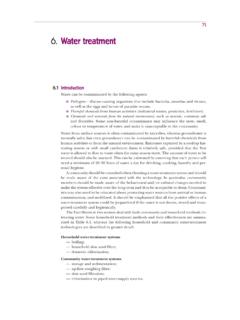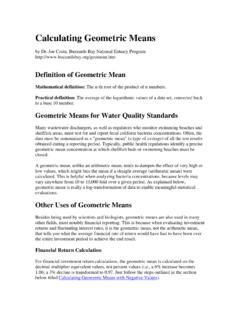Transcription of Calculating and Measuring Power in Three Phase Circuits
1 PDHonline Course E344 (6 PDH). Calculating and Measuring Power in Three Phase Circuits Joseph E. Fleckenstein, 2013. PDH Online | PDH Center 5272 Meadow Estates Drive Fairfax, VA 22030-6658. Phone & Fax: 703-988-0088. An Approved Continuing Education Provider PDH Course E344 Calculating and Measuring Power in Three Phase Circuits Joseph E. Fleckenstein TABLE OF CONTENTS. Section Description Page 1. Introduction _____ 5. 2. Calculating Power in Single Phase Circuits _____ 6. 2A. Single Phase Voltage and Single Phase Current _____ 6. 2B. Single Phase Power _____ 8. 2C. Kilowatts, Lumens, BTU's and Horsepower _____ 13. 3. Calculating Power in Balanced Three Phase Circuits_____ 14. 3A. General _____ 14. 3B.
2 Calculating Power in Balanced Three Phase Wye Circuits _____ 18. 3B1. General _____ 19. 3B2. Calculating Power in Balanced Three Phase Wye Circuits - Resistive Loads _____ 20. 3B2a. Using Phase Parameters _____ 20. 3B2b. Using Line Parameters _____ 20. 3B3. Calculating Power in Balanced Three Phase Wye Circuits Inductive or Capacitive Loads __ 21. 3B3a. Using Phase Parameters _____ 21. 3B3b. Using Line Parameters _____ 21. 3C. Calculating Power in Balanced Delta Three Phase Circuits _____ 21. 3C1. General _____ 21. 3C2. Calculating Power in Balanced Three Phase Delta Circuits - Resistive Loads _____ 22. 3C2a. Using Phase Parameters _____ 22. 3C2b. Using Line Parameters _____ 22. 3C3. Calculating Power in Balanced Three Phase Delta Circuits Inductive or Capacitive _____ 23.
3 3C3a. Using Phase Parameters _____ 23. 3C3b. Using Line Parameters _____ 23. 4. Calculating Power in Unbalanced Three Phase Circuits _____ 23. 4A. General _____ 23. 4B. Calculating Power in Unbalanced Three Phase Wye Circuits _____ 23. Joseph E. Fleckenstein Page 2 of 88. PDH Course E344 4B1. General _____ 23. 4B2. Calculating Power in Unbalanced Three Phase Wye Circuits - Resistive Loads _____ 24. 4B2a. Using Phase Parameters _____ 24. 4B2b. Using Line Parameters _____ 25. 4B3. Calculating Power in Unbalanced Three Phase Wye Circuits Inductive or Capacitive Loads 26. 4B3a. Using Phase Parameters _____ 26. 4B3b. Using Line Parameters _____ 27. 4C. Calculating Power in Unbalanced Three Phase Delta Circuits _____ 29.
4 4C1. General _____ 29. 4C2. Calculating Power in Unbalanced Three Phase Delta Circuits - Resistive Loads _____ 29. 4C2a. Using Phase Parameters _____ 29. 4C2b. Using Line Parameters _____ 30. 4C3. Calculating Power in Unbalanced Three Phase Delta Circuits Inductive or Capacitive _____ 30. 4C3a. Using Phase Parameters _____ 30. 4C3b. Using Line Parameters _____ 31. 4D. Calculating Power in a Three Phase Circuit with Mixed Wye and Delta Loads __ 35. 4D1. General _____ 35. 4D2. Using Phase Data _____ 36. 4D3. Using Line Data _____ 36. 5. Measuring Power in a Single Phase Circuit _____ 36. 5A. General _____ 36. 6. Measuring Power in Three Phase Three Wire Circuits _____ 37. 6A. General _____ 38. 6B. Using One Single Phase Wattmeter to Measure Power in a Three Phase Three Wire Circuit _____ 40.
5 6E. Using a Three Phase Wattmeter to Measure Power in a Three Wire Three Phase Circuit _____ 46. 7. Measuring Power in a Three Phase Four Wire Circuit_____ 48. 7A. General _____ 48. 7B. Using One Single Phase Wattmeter to Measure Power in a Three Phase Four Wire Circuit _____ 48. 7C. Using Three Single Phase Wattmeters to Measure Power in a Three Phase Four Wire Circuit _____ 49. 7D. Using a Three Phase Wattmeter to Measure Power in a Three Phase Four Wire Circuit _____ 50. 8. Power Analyzers and Power Quality Meters _____ 51. Joseph E. Fleckenstein Page 3 of 88. PDH Course E344 9. Summary of Symbols and Equations _____ 53. 9A. Symbols _____ 53. 9B. Equations _____ 54. 10. References _____ 58. Appendix A - Demonstration that Equations 105 is the equivalent of Equation 106 _____ 60.
6 Appendix B. - Table of Computed Values of Instantaneous Power for Example 1 _____ 62. Appendix C - Demonstration that Total Power of an Unbalanced Delta Circuit is Equivalent to that of an Assumed Wye Circuit _____ 64. Appendix D Proof of Two Wattmeter and Three Wattmeter methods . _____ 70. Appendix E - Table of Typical Three Phase Power Values vs. t for One Cycle _____ 79. Appendix F Equations for Calculating Currents _____ 82. Joseph E. Fleckenstein Page 4 of 88. PDH Course E344 Calculating and Measuring Power in Three Phase Circuits 1. Introduction The generation and transmission of electricity is commonly accomplished by means of Three Phase Circuits . Although electrical service to residential buildings in the USA are exclusively by single Phase Circuits , electrical service to commercial and industrial users are usually by means of Three Phase Circuits .
7 The distribution of electrical Power within these buildings is mostly accomplished by means of Three Phase Circuits . And, all larger motors are almost exclusively of the Three Phase type. In short, Three Phase Circuits are the most practical means of dealing with larger amounts of electrical Power . When planning a new Three Phase circuit, it very often becomes necessary for an engineer to determine the Power those Circuits will require. Likewise, the need may arise to determine the Power consumption of an existing installation. Sometimes, these values may be established by calculation. On the other hand, it sometimes becomes necessary to take measurements in order to determine the Power that is being used by an existing installation.
8 In the case of an existing installation, calculations and measurements go hand in hand. If measurements are to be made, a person must first know what measurements are to be made and, secondly, how are field measurements converted to actual Power values. A number of conditions have a bearing on the subject. There are delta connected loads and wye connected loads; there are Three Phase Three wire Circuits and Three Phase four wire Circuits . And, of course, there are balanced loads and unbalanced loads. This spectrum of possible scenarios can be confusing to a person who may not regularly deal with Three Phase Power . This course treats the subject of Three Phase Power in detail and in a manner that a reader, well experienced in Three Phase Circuits or otherwise, will find Joseph E.
9 Fleckenstein Page 5 of 88. PDH Course E344 easy to follow. The course considers all of the possible types of Three Phase Circuits - balanced, unbalanced, Three wire, four wire, wye and delta Circuits . The course is arranged so that Power values may be determined from calculations or measurements and from either Phase parameters or line parameters. Numerous diagrams and examples are used in the course to explain the concepts of the course in simple and unambiguously terms. In the spirit of presenting subject matter in easily understood concepts the course avoids the use of complex variables and polar notation. Rather the more simple method of vector algebra is used. 2. Calculating Power in Single Phase Circuits To better understand Three Phase Power , a person would be well advised to first review and understand the principles applicable to single Phase Power .
10 After all, a Three Phase circuit is essentially a combination of Three separate single Phase Circuits which happen to have peaks and valleys separated by a period of time. Following is a brief review of the principles involved in single Phase Power . 2A. Single Phase Voltage and Single Phase Current In general, the instantaneous voltage in a single Phase AC electrical circuit with respect to time can be expressed by the relationship, vi = (vPK) sin t Equation 101. where, vi = instantaneous value of voltage (volts) i vPK = peak value of instantaneous voltage v (volts). = 2 f (radians). f = frequency (hz). t = time (sec). Similarly, instantaneous current can be expressed as, ii = iPK sin ( t + SP) Equation 102.















